
Quadratic Transformations - HS Algebra I
- Subject:
- Mathematics
- Material Type:
- Lesson Plan
- Date Added:
- 07/18/2022

Quadratic Transformations - HS Algebra I

Babysitting - Grade 8

Bike Ride - Grade 8

Robyn's Ride - Grade 8

Learn about the fundamental connections between math and music, in four Acts: "Rhythm," "Frequency," "Harmony," and "Fractals." Concepts presented in the video documentary are reinforced by hands-on experiments using the Google Chrome Music Lab Experiments. Learn the instructional design process used in creation of The Majesty of Music and Math incorporating Universal Design for Learning and the methodology of assessing non-cognitive skills using a combination of gains in Experience Level, Depth of Knowledge, and Performance Quality.
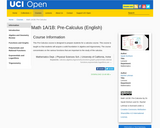
This Pre-Calculus course is designed to prepare students for a calculus course. This course is taught so that students will acquire a solid foundation in algebra and trigonometry. The course concentrates on the various functions that are important to the study of the calculus.

Mathematics explained: Here you find videos on various math topics:
Pre-university Calculus (functions, equations, differentiation and integration)
Vector calculus (preparation for mechanics and dynamics courses)
Differential equations, Calculus
Functions of several variables, Calculus
Linear Algebra
Probability and Statistics
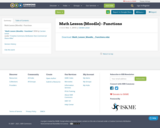
Math Lesson (Moodle) - Functions

Interactive resources including videos and activities from the Mathematics Vision Project. In these lessons students will review Families of Functions and then develop understanding of combining functions.Lessons were taken from the Mathematics Vision Project.
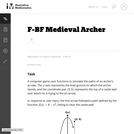
This task addresses the first part of standard F-BF.3: ŇIdentify the effect on the graph of replacing f(x) by f(x)+k, kf(x), f(kx), and f(x+k) for specific values of k (both positive and negative).Ó Here, students are required to understand the effect of replacing x with x+k, but this task can also be modified to test or teach function-building skills involving f(x)+k, kf(x), and f(kx) in a similar manner.

CK-12 Foundation's Middle School Math Grade 6 Flexbook covers the fundamentals of fractions, decimals, and geometry. Also explored are units of measurement, graphing concepts, and strategies for utilizing the book's content in practical situations.
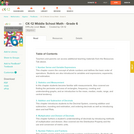
Provides teaching tips, information on common errors, differentiated instruction, enrichment, and problem solving for teachers to use with the CK-12 Middle School Math - Grade 6, Student Edition.
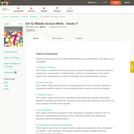
A work in progress, CK-12's Math 7 explores foundational math concepts that will prepare students for Algebra and more advanced subjects. Material includes decimals, fractions, exponents, integers, percents, inequalities, and some basic geometry.

This course is the first of a two term sequence in modeling, analysis and control of dynamic systems. The various topics covered are as follows: mechanical translation, uniaxial rotation, electrical circuits and their coupling via levers, gears and electro-mechanical devices, analytical and computational solution of linear differential equations, state-determined systems, Laplace transforms, transfer functions, frequency response, Bode plots, vibrations, modal analysis, open- and closed-loop control, instability, time-domain controller design, and introduction to frequency-domain control design techniques. Case studies of engineering applications are also covered.

Modeling, Functions, and Graphs covers the content of a typical college algebra course with an emphasis on functions and modeling; when combined with a trigonometry text or supplement, this text can be used in a precalculus course.
The text employs a variety of applications to motivate mathematical thinking. Each chapter opens with a problem of historical or contemporary significance highlighting the material in the chapter, and includes by an Investigation that previews the skills to be introduced. These Investigations can be used in class as guided explorations or as projects for small groups. We have also provided a set of more challenging Projects at the end of each chapter.
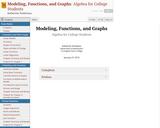
Mathematics, as we all know, is the language of science, and fluency in algebraic skills has always been necessary for anyone aspiring to disciplines based on calculus. But in the information age, increasingly sophisticated mathematical methods are used in all fields of knowledge, from archaeology to zoology. Consequently, there is a new focus on the courses before calculus. The availability of calculators and computers allows students to tackle complex problems involving real data, but requires more attention to analysis and interpretation of results. All students, not just those headed for science and engineering, should develop a mathematical viewpoint, including critical thinking, problem-solving strategies, and estimation, in addition to computational skills. Modeling, Functions and Graphs employs a variety of applications to motivate mathematical thinking.
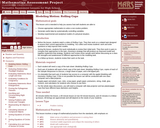
This lesson unit is intended to help teachers assess how well students are able to: choose appropriate mathematics to solve a non-routine problem; generate useful data by systematically controlling variables; and develop experimental and analytical models of a physical situation.
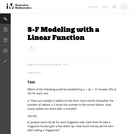
The primary purpose of this task is to elicit common misconceptions that arise when students try to model situations with linear functions. This task, being multiple choice, could also serve as a quick assessment to gauge a class' understanding of modeling with linear functions.
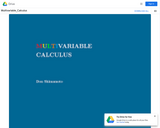
This book covers the standard material for a one-semester course in multivariable calculus. The topics include curves, differentiability and partial derivatives, multiple integrals, vector fields, line and surface integrals, and the theorems of Green, Stokes, and Gauss. Roughly speaking the book is organized into three main parts corresponding to the type of function being studied: vector-valued functions of one variable, real-valued functions of many variables, and finally the general case of vector-valued functions of many variables. As is always the case, the most productive way for students to learn is by doing problems, and the book is written to get to the exercises as quickly as possible. The presentation is geared towards students who enjoy learning mathematics for its own sake. As a result, there is a priority placed on understanding why things are true and a recognition that, when details are sketched or omitted, that should be acknowledged. Otherwise the level of rigor is fairly normal. Matrices are introduced and used freely. Prior experience with linear algebra is helpful, but not required.

(Nota: Esta es una traducción de un recurso educativo abierto creado por el Departamento de Educación del Estado de Nueva York (NYSED) como parte del proyecto "EngageNY" en 2013. Aunque el recurso real fue traducido por personas, la siguiente descripción se tradujo del inglés original usando Google Translate para ayudar a los usuarios potenciales a decidir si se adapta a sus necesidades y puede contener errores gramaticales o lingüísticos. La descripción original en inglés también se proporciona a continuación.)
En el primer tema de este módulo de 15 días, los estudiantes aprenden el concepto de una función y por qué las funciones son necesarias para describir conceptos geométricos y ocurrencias en la vida cotidiana. Una vez que se proporciona una definición formal de una función, los estudiantes consideran funciones de tarifas discretas y continuas y comprenden la diferencia entre los dos. Los estudiantes aplican su conocimiento de las ecuaciones lineales y sus gráficos del módulo 4 a los gráficos de funciones lineales. Los estudiantes inspeccionan la tasa de cambio de funciones lineales y concluyen que la tasa de cambio es la pendiente de la gráfica de una línea. Aprenden a interpretar la ecuación y = mx+b como definir una función lineal cuyo gráfico es una línea. Los estudiantes comparan funciones lineales y sus gráficos y también obtienen experiencia con funciones no lineales. En el segundo y último tema de este módulo, los estudiantes extienden lo que aprendieron en el grado 7 sobre cómo resolver los problemas del mundo real y las matemáticas relacionadas con el volumen de sólidos simples para incluir problemas que requieren las fórmulas para conos, cilindros y esferas.
Encuentre el resto de los recursos matemáticos de Engageny en https://archive.org/details/engageny-mathematics.
English Description:
In the first topic of this 15 day module, students learn the concept of a function and why functions are necessary for describing geometric concepts and occurrences in everyday life. Once a formal definition of a function is provided, students then consider functions of discrete and continuous rates and understand the difference between the two. Students apply their knowledge of linear equations and their graphs from Module 4 to graphs of linear functions. Students inspect the rate of change of linear functions and conclude that the rate of change is the slope of the graph of a line. They learn to interpret the equation y=mx+b as defining a linear function whose graph is a line. Students compare linear functions and their graphs and gain experience with non-linear functions as well. In the second and final topic of this module, students extend what they learned in Grade 7 about how to solve real-world and mathematical problems related to volume from simple solids to include problems that require the formulas for cones, cylinders, and spheres.
Find the rest of the EngageNY Mathematics resources at https://archive.org/details/engageny-mathematics.